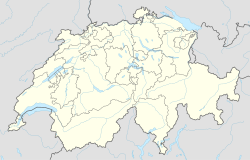Le Landeron
| Le Landeron | ||
|---|---|---|
 |
||
|
||
| Coordinates: 47°3′N 7°4′E / 47.050°N 7.067°ECoordinates: 47°3′N 7°4′E / 47.050°N 7.067°E | ||
| Country | Switzerland | |
| Canton | Neuchâtel | |
| District | Neuchâtel | |
| Area | ||
| • Total | 10.31 km2 (3.98 sq mi) | |
| Elevation | 434 m (1,424 ft) | |
| Population (Dec 2015) | ||
| • Total | 4,501 | |
| • Density | 440/km2 (1,100/sq mi) | |
| Postal code | 2525 | |
| SFOS number | 6455 | |
| Localities | Combes | |
| Surrounded by | Cressier, Enges, Gals (BE), La Neuveville (BE), Lignières | |
| Twin towns | Solothurn (Switzerland) | |
| Website |
www SFSO statistics |
|
Le Landeron is a municipality in the district of Neuchâtel in the Swiss canton of Neuchâtel.
Le Landeron is first mentioned about 1209 as Landiron.
The first traces of human habitation near Le Landeron were the remains of a pottery workshop (961-957 BC) discovered on the banks of the Thielle. At Les Carougets there is a grave from the late Bronze Age, a Roman villa and traces of the foundations of huts from the Early Middle Ages. Furthermore, several Roman statuettes have been discovered, including Hercules, a rooster and what may be a peacock.
The name Le Landeron appears for the first time around 1209, as a place name mentioned in the fishing rights of the neighboring Benedictine monastery of St. Johannsen in Erlach. Since it was given as a place name, it appears that the area where the town now stands was not inhabited. The nearby houses were up in the Jura hills and were grouped under the name Nugerol. The area around what is now La Tour was once the site of a fortification, which was destroyed around 1309. The Duke of Austria forbade anyone to rebuilt the fortifications. On 1 September 1325, Rudolph IV of Neuchâtel bought the Le Landeron meadow in the Thielle valley. In 1328-29 he built a fortified town there. The town was founded to protect the eastern part of the county of Neuchâtel and to control the streets and waterways of the Jura foothills. Le Landeron took the old rights of Nugerol which were comparable to those of citizens of Neuchatel. In 1350 Count Louis of Neuchâtel officially recognized that these rights applied to the town. In 1373, the new mistress of the town, Varenne of Neuchâtel, granted it some additional rights and it became the capital of the Barony of Le Landeron. However, in 1424, the Barony came back under the direct rule of the Counts of Neuchatel. They retained the right to rule themselves as a mostly independent town. They had their own town banner and a town council in which the citizens of Cressier appointed a third of the members.
...
Wikipedia



